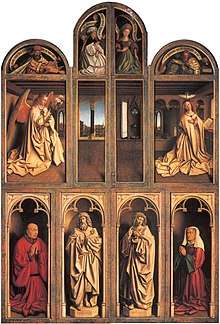
Back قطعة مذبح Arabic Oltářní obraz Czech Altertavle Danish Altarbild German Altarero Esperanto Altarimaal Estonian Erretaula Basque قطعه محراب Persian Alttaritaulu Finnish Pictiúr nó dealbh altóra Irish

An altarpiece is an work of art in painting, sculpture or relief representing a religious subject made for placing at the back of or behind the altar of a Christian church.[2] Though most commonly used for a single work of art such as a painting or sculpture, or a set of them, the word can also be used of the whole ensemble behind an altar, otherwise known as a reredos, including what is often an elaborate frame for the central image or images. Altarpieces were one of the most important products of Christian art especially from the late Middle Ages to the era of Baroque painting.[3]

The word altarpiece, used for paintings, usually means a framed work of panel painting on wood, or later on canvas. In the Middle Ages they were generally the largest genre for these formats. Murals in fresco tend to cover larger surfaces. The largest painted altarpieces developed complicated structures, especially winged altarpieces with hinged side wings that folded in to cover the main image, and were painted on the reverse with different simpler images. Often this was the normal view shown in the church, except for Sundays and feast days, when the wings were opened to display the main image.[4] At other times visitors could usually see this by paying the sacristan.
Altarpieces with many small framed panels are called polyptychs; triptychs have a main panel, and two side ones. Diptychs, with only two equally sized panels, were usually smaller portable pieces for individuals.[4] The predella is a row of much smaller scenes running below the main panel; often these showed narrative scenes related to the subject of the main image. They were only properly visible from close up, but the extra height allowed the main panels above to be clearly seen by the congregation, and any shutters to be opened and closed with less disturbance to other items on the altar.[4]
Many altarpieces have now been removed from their church settings, and often from their elaborate sculpted frameworks, and are displayed as more simply framed paintings in museums and elsewhere.